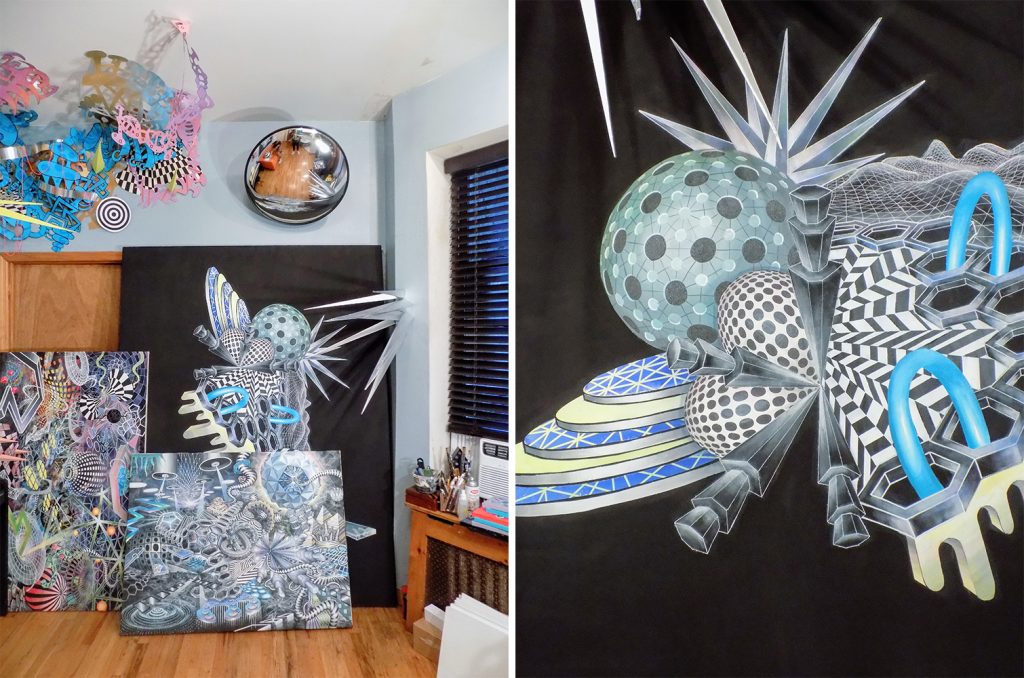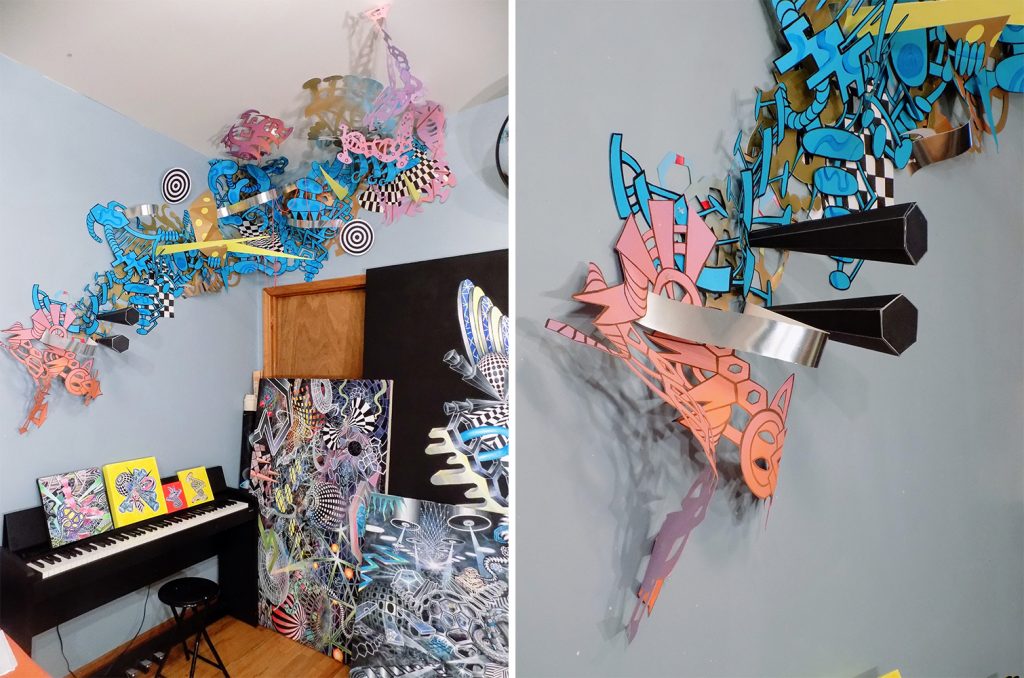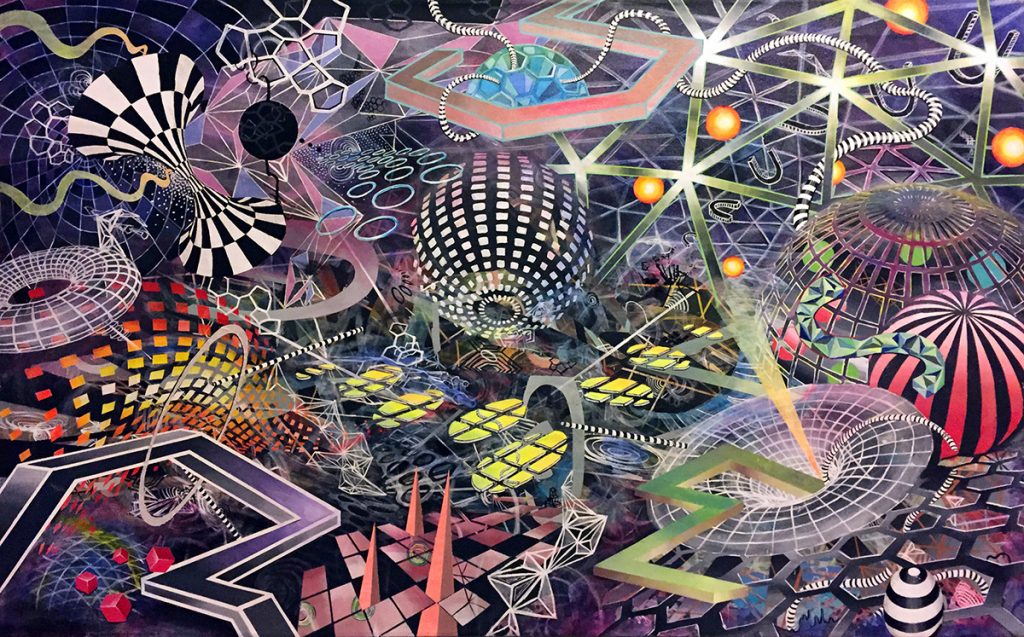Studio Visit: Artist Jon Barwick
The NYC-based artist creates rich, layered work inspired by architecture and rooted in visionary techniques

Instantly striking and undoubtedly worthy of a closer look, Jon Barwick‘s painted works boast immense depth—the kind that calls to mind dense city spaces. Offering one scene upon first glance and hundreds more when you’re mere inches away, the paintings are smattered with motifs and objects that jut out toward the viewer and back into a seemingly distant abyss. All of this happens courtesy of acrylic on canvas—oftentimes large-scale.

The University of Georgia-trained artist refers to the genre of his work as “visionary.” He’s concentrated on this specific style now for 15 years. For viewers, it lies somewhere between a fish-eyed portrayal of a future-forward city and imagery from a space-based art film. “My imagination is my main resource,” he says. “I like to be able to invent stuff. Not that everything I’m inventing—if I need a dodecahedron rendered perfectly, I have to go to the internet. But for my resources I always go back to my imagination and drawing and doodles. It helps with originality. If your resource is inside it’s harder for people to copy.”

“[The category] my work can fall in is called visionary art,” he reiterates. “Not that I’m some artistic genius, but ‘visionary’ just in that the imagery is derived from your internal visions and not so much the outside world. Although obviously everything inside your head somehow starts on the outside world.”
His pieces, specifically those that occupy every single swatch of the canvas, seem to have no starting point. It’s not that they’re unorganized (if you look closely you’re sure to find layer upon layer of details without smudging or amorphousness), but they do not direct viewers’ attention to any single point. They have an almost gravitational pull that can be difficult to escape. Even Barwick admits that he’ll return to a piece and find objects or intersections he’d forgotten he painted.

“People are like, ‘Oh, you must love sci-fi,'” he says, referring to the sort of intergalactic feel of his pieces. “But actually no, I don’t really like it as a genre. I don’t watch sci-fi movies. I don’t read comic books.” His interests are rooted in places and things and less in the vein of the abstract worlds people expect him to enjoy. “I like architecture almost just as much as contemporary art. I can pull just as much inspiration just looking up in the air,” he says. “Geometry, form, pattern, repetition. I love modern art. I like paintings by artists who are alive and working today.”

He also mentions a few childhood experiences that have made their way into his work—and have arguably become his most-used motif. “I was fascinated with rocks when I was a kid,” he says. “I liked minerals and went with my dad digging in old mines for gems. I was drawn to crystals and that form—the color form—for whatever reason.”

Inside Barwick’s Upper West Side studio, his pieces hang on the wall above a bright orange couch, sit in a stack in corner of the room and haunt (this time a paper work for an upcoming installation) from above. Crystals protrude from the wall at various heights too.
“I don’t ever start with a big plan,” he says, of his process. Though some visual themes appear in multiple pieces, there certainly isn’t a repeatable formula behind his work. “Sure, I might set some parameters, [and then] it’s almost like a game. I will start with a motif and then I’ll just put it down and then put something else down and then I have a starting point and it’ll inform my next decisions. I have all kinds of imagery I’ve been developing so that if I’m stuck, I can just come up with something.”

“The thing about layering is you always are going to end up having to cover up something,” he continues. “So, the thing is to find the moments that are most exciting and let those come to the front. Then if something is not as successful, you can cover it up. Painting is very forgiving. If you don’t like something, you just paint over it.”

Barwick’s process is rooted in session painting. He’ll find himself in front of the canvas until he’s happy with what’s there. Sometimes pieces take four to five weeks—though he cannot pinpoint exactly how many hours he’s allocated to each piece. Other works, like a few smaller canvases he’s shipping off to a show in Scotland, inherently move more quickly. His paper works require similar shifts; he’ll pull from his lexicon of imagery and rapidly apply them as he sees fit.
“People will see a picture on Instagram and they’re like, ‘Is this digital?’ or ‘What program did you use?'” he says. “I get a kick out of it. If people think a computer made this work, I’m like, ‘Sure, I’m fine with that.’ But obviously if you see it in person you’ll see and feel that the layers are physical.”
Hero image: “Eyes in the Sky” (2016) courtesy of Jon Barwick












